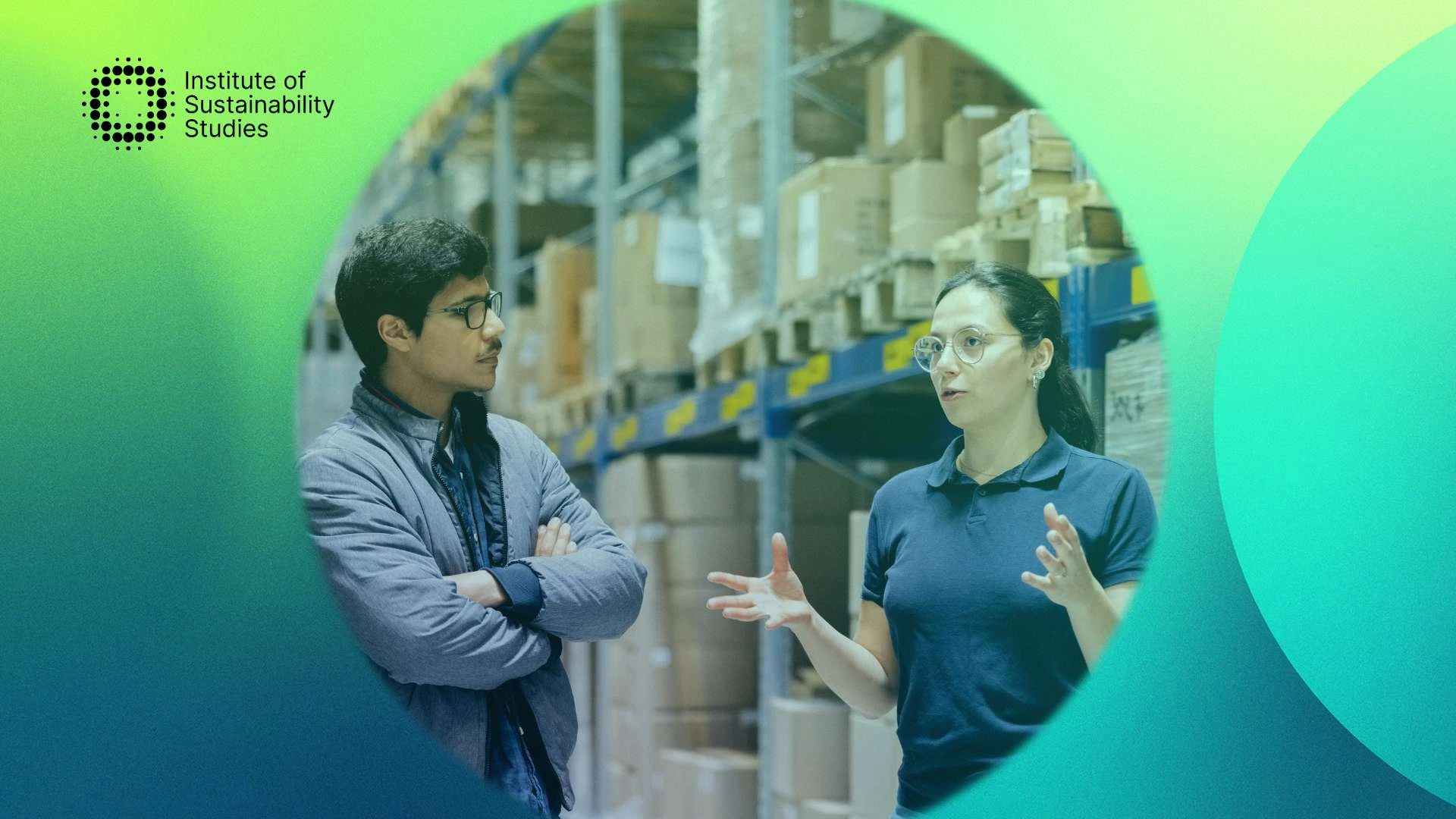In an era defined by disruption and rising expectations, supply chains have become more than just operational infrastructure, they’re strategic engines of growth. Businesses that embed sustainability into their sourcing, logistics, and supplier partnerships are managing risk but also unlocking competitive advantage. From boosting brand trust to opening up new markets, sustainable supply chain solutions are reshaping what business success looks like. Keep reading as we explore how these solutions can drive measurable revenue growth and support resilient, future-ready business sustainability strategies.
How can a supply chain be sustainable?
A supply chain can be sustainable by integrating environmental, social, and economic considerations into every stage of sourcing, production, distribution, and end-of-life processes. The goal is to minimise negative impacts while maximising long-term value for the business, society, and the planet. Here’s how:
1. Source responsibly
- Choose suppliers that follow ethical labour practices and minimise environmental harm.
- Prioritise certified materials (FSC, fair trade, GOTS) and local sourcing to reduce emissions.
2. Reduce emissions and waste
- Measure and manage carbon emissions across all supply chain tiers (especially Scope 3).
- Optimise logistics to lower fuel use and reduce packaging waste.
3. Increase transparency
- Map the supply chain, disclose practices, and track performance using digital tools.
- Implement supplier codes of conduct and conduct regular audits or third-party verifications.
4. Design for circularity
- Extend product lifecycles through reuse, repair, and recycling.
- Develop closed-loop systems to keep materials in use and reduce raw material extraction.
5. Engage stakeholders
- Collaborate with suppliers, customers, and employees to co-create solutions.
- Provide training and incentives to improve supplier sustainability performance.
6. Integrate sustainability into procurement
- Embed ESG criteria into purchasing decisions.
- Use life cycle assessments (LCAs) to evaluate environmental and social impacts.
7. Monitor, report, and improve
- Set clear sustainability targets and track progress with KPIs.
- Report transparently to regulators, investors, and stakeholders under frameworks like the Global Reporting Initiative (GRI) or Corporate Sustainability Reporting Directive (CSRD).
Strengthen ESG capability and unlock long-term value with
flexible, expert-led sustainability training built for impact
How sustainable supply chain solutions grow revenue
Sustainable supply chains contribute to revenue growth by driving efficiency, building customer trust, unlocking new markets, and improving resilience.
Meeting customer demand
Consumers increasingly prefer to buy from responsible companies. According to McKinsey, over 70 percent of consumers are willing to pay a premium for sustainably produced goods. Companies with transparent, ethical supply chains can charge higher prices, retain customers, and win market share.
Enhancing brand value and trust
A sustainable supply chain demonstrates a commitment to ethical sourcing and environmental stewardship – qualities that strengthen brand reputation. Nielsen research found that brands with strong sustainability credentials grew 5.6 times faster than those without.
Gaining a competitive advantage in procurement
Many large buyers now prioritise suppliers with credible ESG performance. For example, Unilever’s ‘Partner with Purpose’ initiative supports suppliers with strong sustainability credentials and offers growth opportunities to those aligned with its climate goals.
Reducing operational costs
Efficiency improvements, such as reducing waste, energy use, and excess inventory, lower costs and improve margins. According to a Harvard Business Review study, companies focusing on sustainability in supply chains saw 9 percent higher revenues and 10 percent lower costs on average.
Accessing new markets and capital
Sustainable supply chains open access to ESG-focused investment, government tenders, and emerging markets where ethical sourcing is a requirement. The World Bank notes that public procurement markets worth 10–15 percent of GDP are increasingly influenced by green standards.
Mitigating disruptions
Sustainable, diversified supply chains are more resilient to climate risks and geopolitical shocks, reducing costly delays and loss of revenue. PwC reports that supply chain disruptions cost companies 42 percent of one year’s EBITDA on average, making resilience a direct revenue protector.
Convert ESG goals into real savings and performance gains with accredited, flexible sustainability training
Key solutions CFOs should focus on
CFOs play a pivotal role in shaping and financing sustainable supply chain strategies.
1. Integrate ESG criteria into supplier evaluation
CFOs should work with procurement teams to incorporate ESG metrics into supplier selection and performance reviews. This ensures that cost considerations are balanced with long-term sustainability risks.
Action: Include ESG scoring or third-party sustainability ratings in supplier contracts.
2. Invest in supply chain transparency tools
Greater visibility enables better risk management and ESG compliance. CFOs should allocate resources toward digital tools like blockchain, IoT, and supply chain mapping platforms that provide real-time insights.
Benefit: Enhanced traceability improves regulatory reporting and investor confidence.
3. Build supplier engagement and capacity
Beyond audits, CFOs can help fund initiatives to train and upskill suppliers in sustainability practices, particularly in emerging markets where ESG maturity may lag.
Solution: Establish supplier sustainability financing or incentives tied to performance improvements.
4. Embed lifecycle costing in capital allocation
Lifecycle costing helps identify the true long-term value of sustainable alternatives, even if the upfront investment is higher. CFOs should shift procurement from lowest-cost to total-cost-of-ownership models.
Result: Better financial justification for sustainable materials, logistics, and redesign.
5. Develop KPIs that link supply chain and financial performance
CFOs should champion the development of cross-functional KPIs that connect supply chain sustainability (e.g. emissions, waste, circularity) to financial outcomes (e.g. margin, risk, growth).
Insight: This helps build internal alignment and strengthens the business case for sustainability.
6. Secure sustainable finance options
CFOs can access green bonds, sustainability-linked loans, and preferential financing tied to supply chain improvements – unlocking capital while demonstrating ESG leadership.
Example: Linking loan interest rates to supplier Scope 3 emissions reductions.
7. Align with Reporting Frameworks and Regulations
Ensuring supply chain disclosures meet frameworks like CSRD or the International Sustainability Standards Board (ISSB) requirements is crucial. CFOs must lead on data readiness and audit-quality ESG reporting.
Priority: Create robust systems to track Scope 3 emissions and human rights due diligence.
Real-world examples of revenue growth through sustainable supply chains
Below are several real-world examples of companies that have driven revenue growth through sustainable supply chains, showcasing the tangible value of integrating environmental and ethical practices:
Unilever – Growth through sustainable sourcing
Unilever’s Sustainable Living Brands, which include Dove, Hellmann’s, and Ben & Jerry’s, grew 69 percent faster than the rest of its portfolio and delivered 75 percent of overall company growth by embedding sustainability across their supply chains. They achieved this by sourcing 100 percent of palm oil from sustainable sources and working closely with farmers to reduce environmental impact.
Patagonia – Customer loyalty through ethical supply chains
Patagonia’s commitment to ethical sourcing, fair labour practices, and environmentally friendly materials has contributed to a doubling of revenue between 2010 and 2020, reaching $1 billion. They did this through transparent sourcing and a circular economy model (e.g. Worn Wear programme). This built a loyal customer base willing to pay a premium.
IKEA – Circular supply chains driving new revenue
IKEA aims to become fully circular by 2030 and has already introduced buy-back schemes and circular product designs. It expects circular services and sustainable products to become a multi-billion-euro revenue stream. The brand is working to achieve this by implementing more sustainable materials (like bamboo, recycled plastic, and wood from FSC-certified sources) and offering repair services has opened up new customer segments.
Nike – Cost and revenue benefits from sustainable manufacturing
Nike’s “Move to Zero” initiative led to significant waste reduction and water savings in production. The introduction of sustainable product lines like Nike Flyleather and Space Hippie contributed to rising sales among eco-conscious consumers. These initiatives helped drive Nike’s FY21 revenue to $44.5 billion, with sustainability becoming a key driver of innovation and brand growth.
Schneider Electric – Profitable green supply chains
Schneider Electric, ranked as one of the world’s most sustainable companies, attributes part of its revenue growth to sustainable supply chain solutions offered to customers. By helping clients reduce energy and emissions, its sustainability business unit has seen double-digit annual growth.
Conclusion
As stakeholder expectations and regulations intensify, sustainable supply chains will be essential. The companies that thrive will be those that treat sustainability as an integrated business strategy, not an isolated initiative. From reducing emissions and waste to creating new value streams through circularity, the potential for impact is immense.
Whether you’re a CFO or supply chain leader, now is the time to build the internal knowledge and systems that connect sustainability with performance. Our corporate sustainability training is designed to help your teams turn ESG ambitions into action – confidently, efficiently, and at scale. Explore our comprehensive product suite and see how we can help future-proof your value chain.
Dedicated to harnessing the power of storytelling to raise awareness, demystify, and drive behavioural change, Bronagh works as the Communications & Content Manager at the Institute of Sustainability Studies. Alongside her work with ISS, Bronagh contributes articles to several news media publications on sustainability and mental health.
- Bronagh Loughlinhttps://instituteofsustainabilitystudies.com/insights/author/bronagh/
- Bronagh Loughlinhttps://instituteofsustainabilitystudies.com/insights/author/bronagh/
- Bronagh Loughlinhttps://instituteofsustainabilitystudies.com/insights/author/bronagh/
- Bronagh Loughlinhttps://instituteofsustainabilitystudies.com/insights/author/bronagh/










